WARNING: This article contains some of our top board game picks from PAX East. We will provide you with a rundown of each game and some minor points we had against them. However, be warned these games are very good. Instructions will be provided if you wish to purchase either of these games. You have been warned.
Reviewing tabletop is always a tricky proposition at a convention like PAX East. Rules explanations and demo games tend to take a lot longer than popping a controller in my hands or settling into the familiar vibe of an FPS. Thankfully for all involved, Boston gave us 33% more PAX this year! I decided to make the most of it and avoid the crowd crush of full-swing Saturday by enjoying some leisurely time with tabletop. Ironically, both of my board gaming picks of that day are post-Kickstarter and have pre-orders that last only a few more weeks (until May hits). So with that in mind I’ve wrapped these two personal picks into a double feature!
Here at Sprites and Dice, we believe in our slogan: life is short, so have fun gaming. We stand behind spreading the word about games we’re excited about, and with that in mind here are two picks that our staff (myself included) had a great time with during the con. If either of these titles interest you, there’s still a little time to get on board with all the Kickstarter extras before the wait for retail.
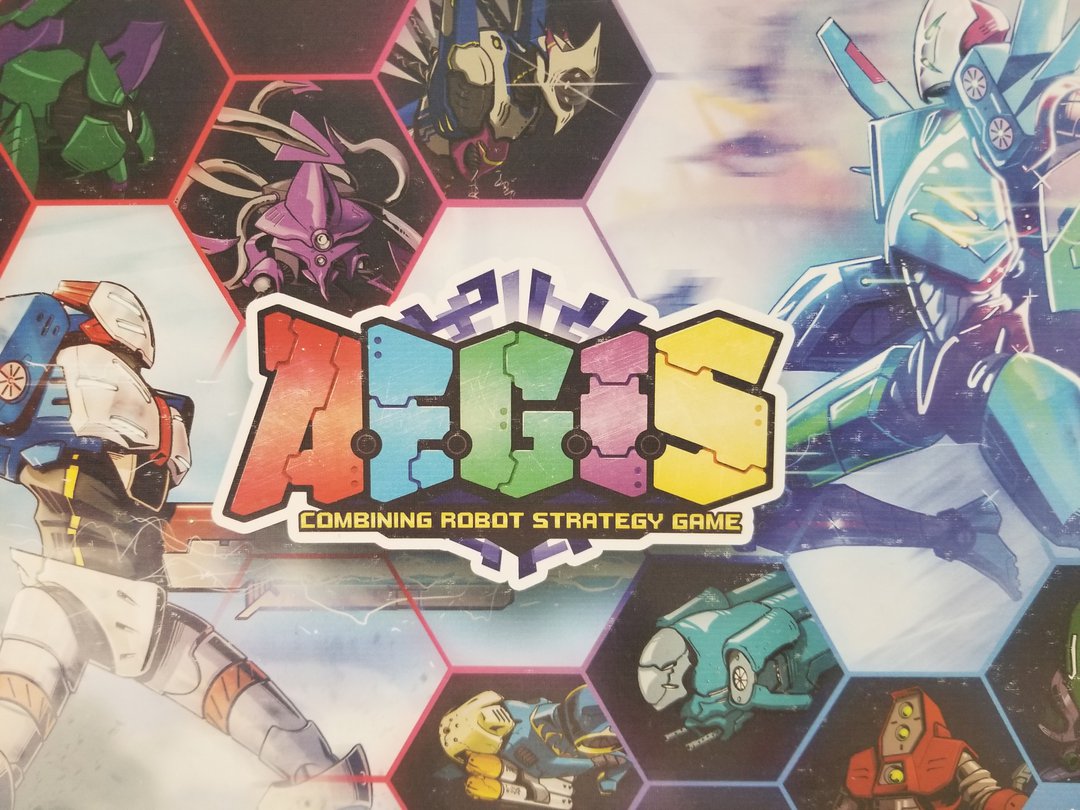
First up, GIANT FIGHTING ROBOTS!
AEGIS: Super Combining Robot Tactics
I hear no shortage on the internet of how Kickstarter has become “an over glorified pre-order system” for large publishers to trim their margins and cut out the middlemen; often times these types of campaigns are looked down upon as unnecessary and money-hungry, with large publishers piggybacking a successful system that was designed to support the little guys. What ever happened to those smaller designers, in need of funding for their ideas to see the light of day?
Well, ladies and gents, this is about one of those little guys. AEGIS is a lot of game packed into not a lot of box. A box about what, you say? Freakin’ fighting robots that can Voltron themselves into all sorts of combined mechs! In the creator’s own words, AEGIS was designed to deliver a tabletop experience not unlike Warhammer 40k or other heavier tabletop wargames, but at a fraction of the cost, table real estate, and learning curve. And on that design promise, it delivers!
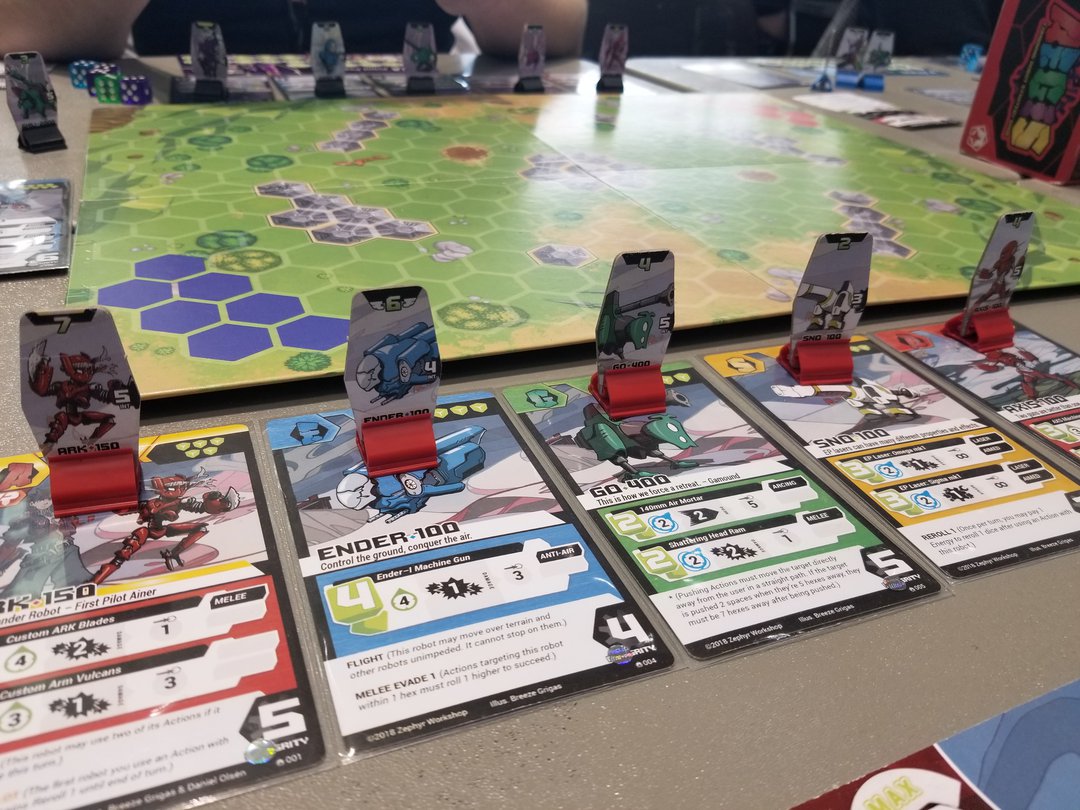
The artwork in this game is the final version. The 80s you see is the 80s you get.
A game of AEGIS is played very simply. You build a team of five robots and take their matching cards and standees. Robots come in one of five classes, and you can mix and match them without any restrictions: Attack (packs a punch), Evasive (the best movement in the game), Guard (the tanky types), Intel (usually inflicts status), and Support (the healers). See what they did there? It spells AEG—nevermind.
You count up the energy points each bot’s card has printed at its top and mark your total energy per turn on a player board. Every turn, you spend these energy points shared amongst your whole team. You can spend a point to move a bot, one per hex, up to their max movement allowance. You can spend points to activate attacks or special abilities on their cards. And you can spend energy to combine two or more robots standing next to each other, replacing their standees on the map with a bigger, badder version. Of course, this being a wargame, there are rules for status, pushing enemies into things (including other enemies), shooting through your own bots, flight, cloaking, and pushing enemies off the map. There’s also a very nice rule for “scrap combining,” a catch-up mechanic that allows you to instantly combine a dead bot with a live one on the field, ensuring one side can still regain some momentum even if they’re getting stomped (because remember, as you lose bots you lose overall team energy to spend on doing stuff). Also, if a key bot dies early, you don’t lose your ability to combine.
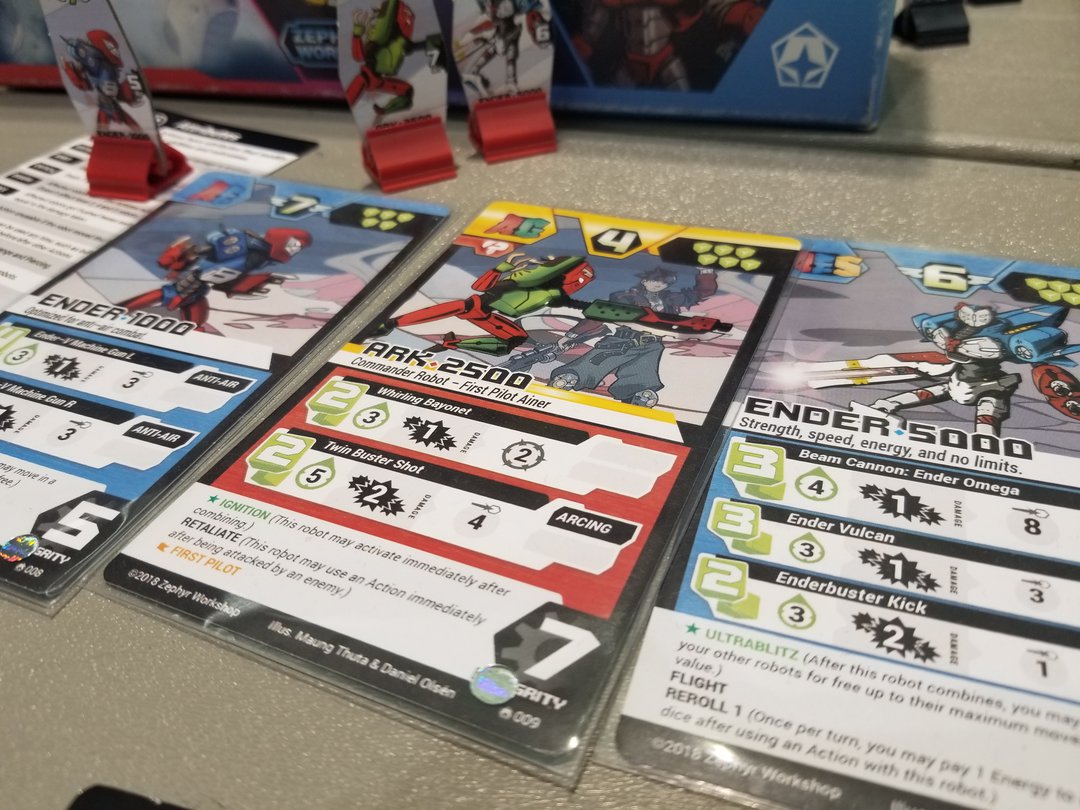
I mean, do you think my opponents will leap across the table if I yell "it's morphin' time" whenever I play this?
This is a game with a rather storied little history. In a nutshell, it’s the product of five years of hard work, false starts, learning about the board game publishing industry, and constant refinement of its systems. Oh, and robots. The addition of lots and lots of robots. The game currently boasts 100 unique robots to build teams from, and you get all that with a double sided board (supporting 2 or 4 players) and moveable terrain obstacles for only $50. For $30 extra dollars, you get a deluxe version with an extra neoprene board that supports up to 6 players,custom-molded dice, and a commander expansion that adds—yes—even more robots to your game.
This game has a lot to like. Again in the creator’s own words, if you want to play a quick shoot-em-up with some robots, this game is good for that. And I agree. I also agree that if you want something a little more deep and tactical, you can get that out of this game. It’s as casual or as serious as you want to get, and that’s no small thing for a game so small to deliver. If I have to offer one complaint, it’s that there’s no guarantee the teams you build (after you break apart the starter packs) will be balanced at all against each other. It’s entirely possible you will have a stomp going on with one team while the other flounders without aim; this might also happen if two players with widely differing skill face off (though let’s face it, that’s not unique to this game). But these complaints are still minor in the overall consideration of this game. I’m told the game will have beginner team suggestions, and frankly if something doesn’t work, scrap it! It takes literally just minutes to build out a new team comp and maybe 20 minutes to play a round with it.
Overall, I like the decision to use standees instead of minis, keeping the cost way down. I like the myriad of ways you can combine the bots (maybe you don’t take one of everything in order to double or triple up on a particular bot class), and I like that you can play the game as casually as you desire. Plus the small box is appealing, I’m not gonna lie. I don’t have a lot of free shelf space these days. If this sounds like something you’re interested in, you can find their pre-order here for the next couple of weeks. Also, the full game is on Tabletop Simulator if you have it, so you can try before you buy.
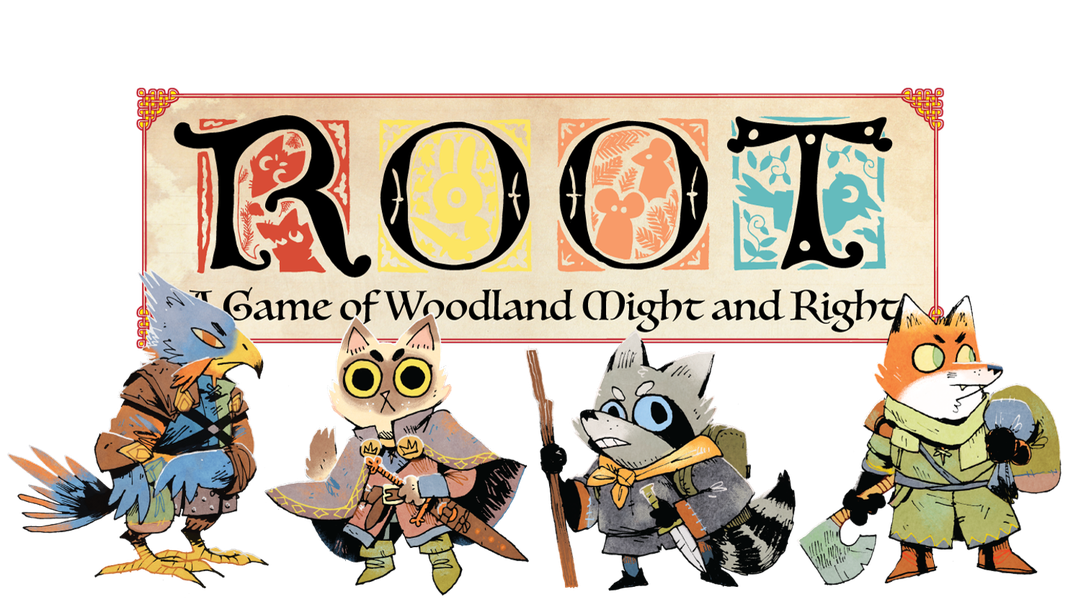
Next on the ticket: artwork by the amazing Kyle Ferrin!
Root: A Woodland Game Of Might And Right
In the interest of full disclosure on this one, I was already excited about Root before I sat down to try a demo game. After playing it, however, it went from something I merely thought would have solid design and artwork into perhaps my most anticipated board game of 2018. Yes, I think this game is that good. I sometimes take for granted that I read online and in social media about way too much board game stuff, and that sometimes people still don’t know about these games. I know this because some kind PAX-goers told me so when they hovered at our demo table to peer at the game I was playing; they were board gamers, but they had no idea what they were looking at. If you’re not sure what the deal is with this one, let me tell you about Root.
Root is brought to us by Leder Games, the same folks that gave us Vast: The Crystal Caverns. I’ve never played Vast, but I’ve heard some people (including people at our local game night) talk highly of it. I’ve also heard it has a wicked learning curve. The game has asymmetrical factions all doing different things to win, and that makes it something of a bear to teach to new players. Root has a similar theme of asymmetrical factions battling for control of the forest, but the game isn’t tough to learn at all. And the reason is that, while everyone plays the game slightly differently in how they take actions, in the end everyone is shooting for the same goal: the same total of victory points or the scoring of special victory condition cards (which everyone has access to). Players also play on the same board, share some of the same rules for movement and combat, and they draw from a common deck of cards. These uniting design elements really go a long way in people picking the game up more quickly.
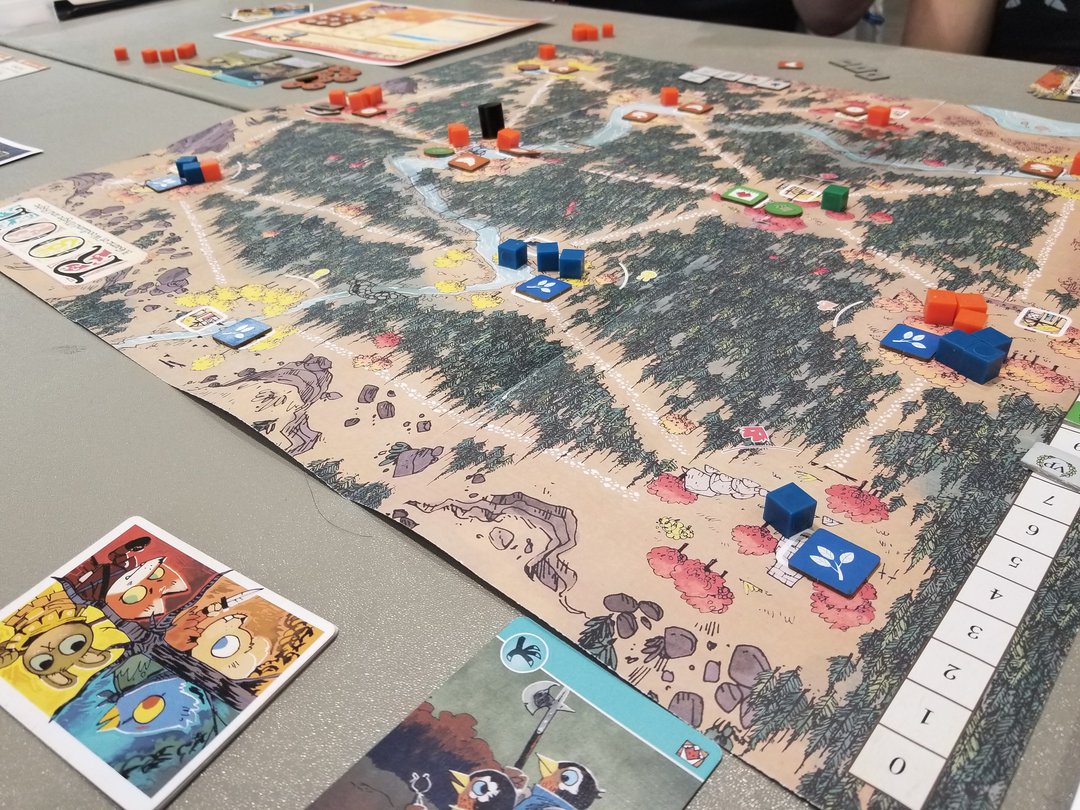
Featured components are demo quality. The actual game will have a nicer quality board and player mats. Woodland meeples will replace the cubes as well.
The two recommended factions to start with are the Marquis de Cat and the Eyrie Dynasties. The Marquis starts off controlling the entire forest, and their objective is to keep up troops to defend their clearings, using the lumber they mill to build buildings which will earn them points. The Eyrie wants to retake their forest, and they get the best military to do so. Initially they start with little, but every turn they must slot cards into their “decree,” increasing the number of actions they perform every turn. They earn points by maintaining their roost tokens in clearings they’ve taken, but if they ever cannot perform part of their ever-growing decree, they lose all the cards they’ve put in it (minus a couple), lose a few points, and cycle their leader bonus; essential their ruler is overthrown from within and they have to ramp up their tempo all over again. The Woodland Alliance brings an element of uncertainty to this conflict, initially not even being on the board but hindering all who move troops on it. As they rally the people Robin Hood style, they gain points, and eventually they can incite a full-blown rebellion and recruit troops (#DoYouHearThePeopleSing)! Finally, the base game comes with the Vagabond. His objective is to keep everyone else from winning long enough to do it himself, wandering around the map earning points off his relations with the other factions and by completing quests.
So, essentially the Marquis is playing a eurogame, while the Eyrie plays Kemet. The Woodland Alliance is out to troll everyone, and the Vagabond is still stuck in his last session of DnD. It’s a glorious mixup of mechanics that really gives the feeling of skirmishes in the early game and full blown war in the late game. It’s hilarious to watch as the Eyrie’s government explodes right when they’re at the Marquis’s doorstep, or you see the looks on your friends’ faces when they turn around exclaiming, “When did the Vagabond become the people’s hero?”
But even more than that, the very mechanics of the game encourage diplomacy, cooperation, and sneaky masterminding. You earn points for crafting items, but the Vagabond can then “buy” them from you by giving you a card. Maybe he gives you a garbage card and “sweet talks” your people, but maybe you arrange an actual deal: that shiny sword he needs in exchange for something you can use against the Marquis. The Vagabond would benefit from you holding that player back, right? Similarly, it’s hilarious to watch the Marquis, about to move an army against your Eyrie warriors, when he realizes that all his marching paths are choked with Alliance influence, draining his cards if he moves. Suddenly, that pain in your Eyrie falcon backside has bought you time to shore yourself up! Deal making is hard baked into the game, rather than being something players are merely encouraged to do.
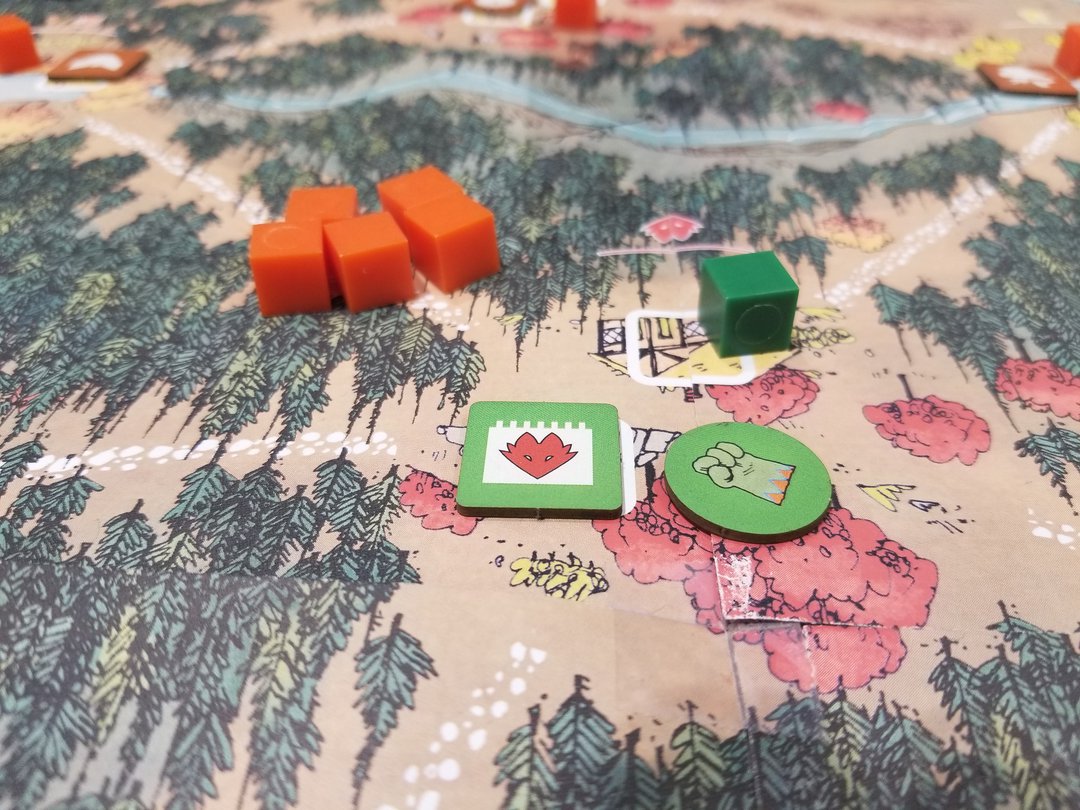
The rebellion uprising removes a large contingent of Cat forces right before they sweep in on me!
No review would be complete without me at least trying to offer some criticism, of course, or at least saying who this game isn’t for. This game I feel, cute as the artwork is, isn’t a great pick for newer gamers or the non-gamer crowd. It’s got some crunchy interactions, and experienced gamers are going to smoke newbies every single time in a game like this. I could easily see newer gamers getting “deer in the headlights” syndrome, as well, so be wary if you have someone in your group who tends to ask how to do a particular thing for the 4th time in a rules explanation. Also, if your friends are going to get annoyed the first time one of you swaps a faction because it means they have to “learn the game again,” yeah, don’t bring this game out with that crowd.
But again, these complains are minor. The game itself, design-wise as well as with its art, is solidly built. The criticisms of it are less of what’s wrong with the game itself and more of who it would best suit. There are some playthroughs on YouTube if you’d like to see it all in action, but keep in mind it looks like they may be using older versions of the rules. There’s a print and play here if again you’d like to try before you buy. The pre-order can be found here, and it will include the base game plus the expansion for a very reasonable $60; other extras like plushies and artwork are available if they tickle your fancy.
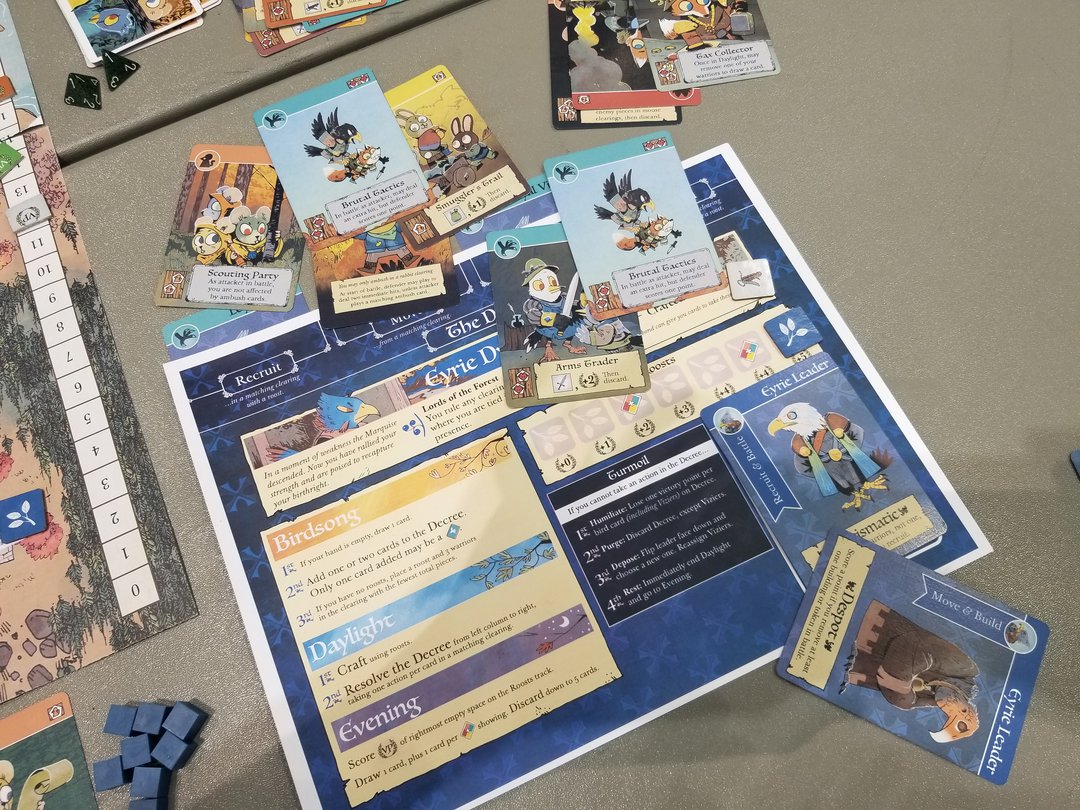
When your beefy bird battalions blow up in your face. Guys, couldn't the challenge for the throne happen AFTER the war we're fighting?
And there you have it! Two very cool, very well-designed highlights of our PAX East 2018. Both Kickstarters have ended, and their pre-orders are open through the end of the month. Whether you choose to partake in either, wait for retail, or pass entirely is up to you. Remember though, with whatever you choose to play with friends and family, life is short, so have fun gaming!